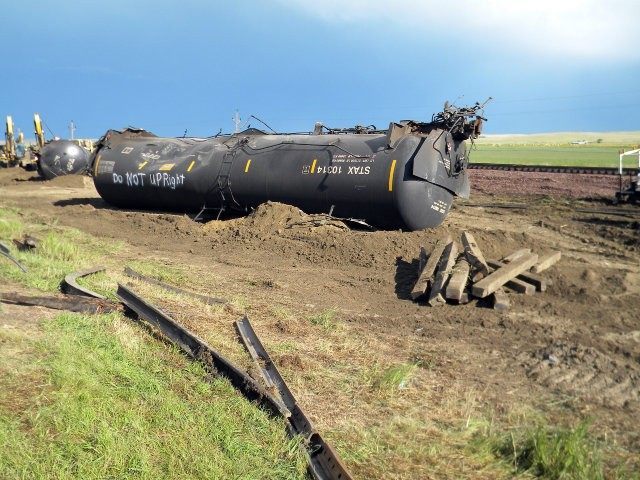BILLINGS, Mont. (AP) — A train that derailed and spilled 35,000 gallons of oil in northeastern Montana was traveling within authorized speed limits, federal officials said Monday as they continued to probe the accident’s cause.
The Burlington Northern Santa Fe Railway train loaded with crude from North Dakota was traveling 44 miles per hour before Thursday’s wreck, U.S. Federal Railroad Administration spokesman Matthew Lehner said.
Officials have said the maximum authorized speed in the area is 45 mph.
Twenty-two cars on the BNSF train derailed near the small town of Culbertson. Lehner said the tank cars were a model known as the “1232,”which is built under a 2011 industry standard intended to be more crash-resistant than earlier designs.
But several recent oil train crashes, including some that caught fire, also involved 1232s and federal officials are seeking to phase out the cars. The oil industry has challenged the timeline for the phase-out in federal court.
The stretch of track where last week’s derailment occurred is inspected at least four times a week, said Matt Jones, a spokesman for the Fort Worth, Texas-based company. Jones did not immediately respond to a request for details on the latest inspection.
The accident triggered a temporary evacuation of nearby homes and a camp for oil-field workers.
No one was hurt and no fire or explosion occurred, but oil leaked from four of the cars. Officials said the spill was quickly contained and there was no immediate evidence that any crude reached a waterway.
The spill marked the latest in a series of wrecks across the U.S. and Canada that have highlighted the safety risks of moving crude by rail.
In recent years, trains hauling crude from the Bakken region of North Dakota and Montana have been involved in fiery derailments in six states. In 2013, a runaway train hauling crude from the Bakken derailed and exploded in Lac-Megantic, Quebec, incinerating much of its downtown and killing 47 people.
Cleanup work along the BNSF line near Culbertson continued Monday, said Daniel Kenney, an enforcement specialist with the Montana Department of Environmental Quality.
BNSF has been asked to sample underground water supplies in the vicinity of the crash as a precaution, Kenney said. For most spills, the state expects cleanup work to be completed and a final report submitted to regulators within 90 says, Kenney said. He added that might not be the case with Thursday’s derailment given the large volume of oil spilled.
Speed restrictions put in place following the derailment were lifted Monday on nearby U.S. Highway 2, the region’s main artery.

COMMENTS
Please let us know if you're having issues with commenting.